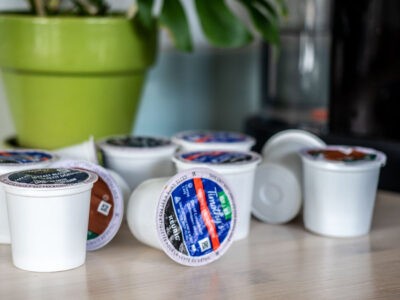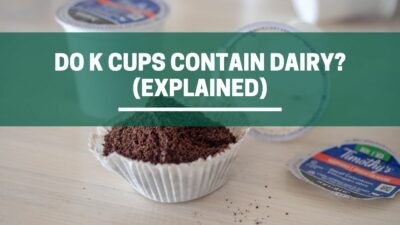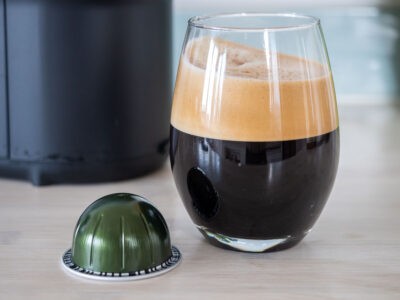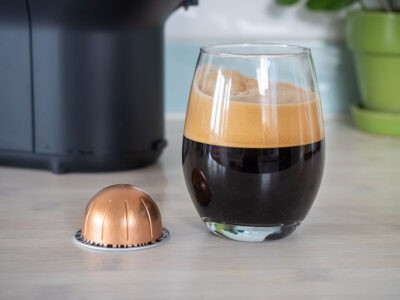Recycling Guides
How To Recycle Coffee Grounds (11 Proven Ways!)
While we may have solved the plastic waste problem thanks to our reusable coffee pods, there’s still another problem that needs addressing: what to do with all the leftover coffee grounds?
Let them pile up in landfills? Keep pouring them down (and potentially blocking) the sink?
In this article, we’ll explore the eleven best ways to make great use of used coffee grounds. Read on and let us know which of these ideas you’re currently using, and which one you’re keen to try out next!
Why Listen To Us? Well, because we KNOW coffee! In fact, we make our own coffee, coffee machine cleaners, and reusable capsules which we've sold to over 41 countries. Our team ouf experts include Tristan (an engineer), Claire (a food writer) and Richy (a barista). So, whether you're looking for a recipe or repair guide, we've got you covered 💚
Table of Contents
A Big Problem With Coffee Grounds
Each cup of coffee requires about 11 grams of grounds. And the world’s bleary-eyed population drinks about 2.25 billion cups of coffee each day.
That means about 18 million tons of wet waste from used coffee grounds. How much is that? Imagine a pile two times higher than most city buildings and 29 city blocks wide!

Unfortunately, those waste grounds typically go to landfills. Because coffee waste includes cellulose, proteins, fats, and water, it produces methane as it decomposes. Methane is a greenhouse gas 25 times more potent than carbon dioxide that contributes to global warming.
What’s to be done? How To Recycle Your Used Coffee Grounds:
An industry has emerged around upcycling coffee grounds to make food flavorings, bio-plastics, cosmetics, and biofuel. But even one person alone can make a difference with these 11 tips for how to recycle used coffee grounds at home:
- Garden Fertilizer
- Compost
- Insect Repellant
- Flea Remover
- Deodorizer
- Natural Cleaner
- Meat Tenderizer
- Skin Exfoliant
- Cellulite reducer
- Hair-growth stimulant
- To stain wood
1. Turn Your Coffee Grounds Into Garden Fertilizer
Coffee grounds contain key nutrients like nitrogen, potassium, and phosphorus—just like plant fertilizer! I sprinkle them on soil around plants to increase growth, absorb heavy metals, and attract worms (just let them cool first!).
Most gardens need to be fertilised to ensure that plants have the nourishment they need to survive. Soil alone doesn’t contain the essential nutrients and minerals needed for optimal plant growth. Plus, as plants grow, they absorb nutrients from the soil, ultimately leaving it depleted.
Coffee grounds also assist in attracting worms, which make for a healthy garden.
It’s as simple as sprinkling coffee grounds onto the soil that surrounds your plants. Quick, convenient, environmentally friendly – what more could you ask for?

2. Add Your Coffee Grounds To The Compost
Composting turns food waste and yard debris into fertile soil for plants. Composting with coffee grounds increases vital nutrients and decreases the greenhouse gas emissions during the process.
If you do not have an immediate need for fertilizer, you can compost your coffee grounds. Composting is a natural process that turns organic items such as food scraps and garden debris into incredibly useful organic fertilizers. Adding compost to your garden can help the soil hold onto more nutrients and water, thereby improving the health of your plants.
How beneficial is adding used coffee grounds to your compost? This study compared four batches of compost containing 0%, 10%, 20% and 40% coffee grounds and found the batch containing 40% coffee grounds produced the fewest greenhouse gas emissions and best quality compost.
Other items that should be added to compost include grass clippings, leaves, bark, shredded newspaper, herbs, egg shells, old bread, alongsidefruit and vegetable trimmings.
Be mindful, adding too many coffee grounds to your compost may have adverse effects. We also recommend only layering around 1-2 centimeters of coffee at one time to prevent suffocating the compost heap since the particles are very fine and can stop air from moving past.

3. Create Your Own Coffee Insect Repellent
Did you know you can use coffee grounds as a natural insect repellant to deter some bugs and insects.
Coffee contains caffeine (you knew that) and diterpene (you didn’t know that), chemicals that repel insects, including mosquitos and fruit flies.
To use coffee grounds as an insect and pest repellent, simply set out bowls of grounds or sprinkle them around outdoor seating areas. You can even throw them in a pot plant and they’ll double as fertiliser
Some resources suggest you can also keep pests out of your garden by scattering coffee grounds around your plants, though this is largely unverified. Try it out for yourself and let us know if it works.

4. Make Coffee Based Flea Remover
Rub coffee grounds into your pet’s coat after a shampoo, and then rinse thoroughly. The chemical compounds in coffee repel fleas and are milder than harsh commercial products. Just remember to keep them on the outside—ingesting coffee can be toxic for pets!
5. Create A DIY Deodorizer – With Coffee!
The nitrogen in coffee grounds combines with carbon to absorb stinky sulfur gas (it wasn’t me). Scrub your hands with coffee after cutting onions. Put a bowl in the fridge. Stow some in your closet or gym bag inside an old sock to create a homemade deodorizer.
Here’s how to use coffee grounds to absorb pesky odors around your home.
- In the Fridge – Just place them in an open container at the back of your fridge or freezer and forget about them as you collect more used grounds. Empty the container after a week or so.
- Around the house – start by drying out the coffee grounds by laying them on a baking tray in the sun or oven at a low temperature. Then, place them in a stocking or muslin cloth and tie a knot, making it into a ball. Leave this in the closet, drawer, or pantry to eliminate any bad smells.
- For your Hands – keep a bowl with coffee grounds near the sink to rub your hands with to get rid of the smell of garlic or fish. You can also add in some toothpaste the create a minty fresh exfoliating paste (perfect for the fish filleting station).

6. A 100% Natural Cleaner
Coffee has natural antibacterial and antiviral properties. And the spent grounds are abrasive. Perfect for scrubbing the sink, polishing cookware, or scouring the grill. Just don’t use them on anything that might stain!
Tip: I recommend mixing 1 part used coffee grounds with 1part baking soda (annother nautral abrasive) and keep this mix on hand to scrub any stubborn pots and pans.
7. Meat Tenderizer
Coffee has natural acids that can break down muscle fibers and proteins in meat. That’s why coffee appears as an ingredient in dry-rub recipes. It adds flavor and cooks into a dark, crispy crust.
So, before you through out your morning coffee, how about recycling it into your evening meal?
To Use:
You can be as conservative or liberal as you want.
- Take a tough cut of chuck steak (for example) and smear on the coffee paste.
- Return to the fridge, and leave for 2 – 8 hours (I like to apply it first thing in the morning)
- When you’re ready to cook, rinse off the coffee rub and cook as you normally would.
8. Make A Coffee Skin Exfoliant
Studies such as this one show that skin care products containing antioxidants and caffeine can help prevent the appearance of aging and reduce under-eye circles.
Caffiene in particular has anti-inflammatory properties and stimulates blood circulation. When used around the eyes, this can help reduce the appearance of dark circles and swelling.
Simply add water or coconut oil to your coffee grounds to form a paste. Apply the mixture under your eyes and let it sit for about 10 minutes before rinsing. Repeat this process daily or as needed.
The antioxidants in coffee can also help fight free radicals, which contribute to skin aging.
Use as a natural scrub on its own or mixed with a bit of honey and coconut oil. It’ll be more delicate on your skin than non-natural exfoliants and you won’t be polluting the environment with nasty microbeads.

9. Cellulite Reducer
The caffeine in coffee can break down fat and increase blood flow, reducing the lumpy appearance of cellulite on thighs and buttocks.
10. Hair-growth Stimulant
Massage coffee into your scalp and hair, then shampoo and rinse normally. Caffeine’s natural properties stimulate and accelerate hair growth.
Is there anything coffee can’t do? Start your day with a cup of coffee, and start recycling your used coffee grounds at home.
11. Use The Coffee Pigment To Stain Wood
Using coffee grounds for wood staining is incredibly cheap, simple and gives you a nice organic effect.
You’ll need some steel wool, vinegar, a mason jar, and of course the spend coffee grounds.
- Place a steel wool pad into a mason jar and add about 1/4 cup of used coffee grounds and about 1 to 2 cups of vinegar.
- Close the container, shake the mixture, and let it stew overnight. (this is the bare minimum, the longer you leave it the darker the stain will become)
- The next day, open the container and gently mix the stain.
- Using gloves, remove the steel wool and apply the stain to the project. As the stain dries it will become darker, so let the stain set for 20 minutes before applying the second coat.
- Repeat until you get the desired color. Remember the stain will look darker when wet so you may want to let it dry before deciding whether to add more.
What does the steel wool and vinegar do?
The iron will dissolve in the vinegar creating a solution (iron acetate). The substance reacts with the tannins in the wood making it darker. This allows the coffee stain, that would fade away quickly in sunlight, to be durable indoors and outdoors.

Thats It!
We hope you enjoyed these 11 tips to reuse your old coffee grounds. Please leave us a comment if you’ve got any other suggestions, or share this with your friends to help spread the word!








Which blend of coffee is better to use as it seems weaker than the pre bought capsules?